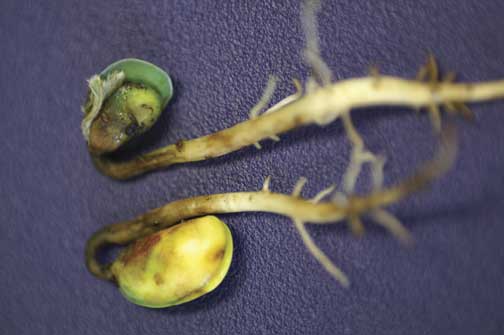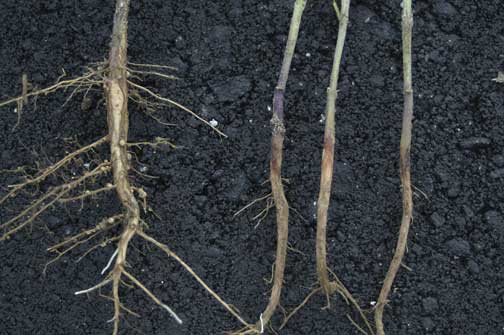Ames, Iowa
March 26, 2007
Fungicide seed treatments in
soybean
by Palle Pedersen, Department of Agronomy, and Alison Robertson,
Department of Plant Pathology
Source:
Integrated Crop
Management IC 498 (3), Iowa
State University
Fungicide seed treatments have
proven invaluable to corn production, and planting treated seed
is a standard practice. But what about soybean
production--should fungicide seed treatments be standard
practice?
First, why use a fungicide seed treatment? Fungicide seed
treatments are used for managing seedling diseases that are
caused by fungal pathogens. Seedling diseases result in lower
plant populations and reduced plant vigor, and as a result,
lower yields in corn. In contrast, however, a reduced stand of
soybean may not always mean a lower yield.
 |
|
Figure 1. Soft, wet rot of the hypocotyl
characteristic of Pythium and Phytophthora seedling
blight. (Alison Robertson) |
Several fungi are able to infect
germinating and cause damping off. These fungi are most often
soilborne, e.g., Phytophthora sojae, Pythium, Rhizoctonia, and
Fusarium spp.; however, seedborne fungi, e.g., Phomopsis, also
can affect germination and cause damping off. Each of the
pathogens is favored by different environmental conditions at
and soon after planting. Very wet conditions are required for
infection by Phytophthora and Pythium, whereas infections by
Rhizoctonia and Fusarium are favored by drier soil conditions.
Soil temperatures also are important. Pythium prefers cool soils
(<60 °F), while Phytophthora prefers warmer soils (60-75 °F) and
Rhizoctonia prefers even warmer soils (>75 °F).
Seedling blights that are caused by Pythium and Phytophthora are
characterized by a soft, wet rot of the hypocotyl and root
tissues (Figure 1). Only laboratory tests are able to
distinguish between these two pathogens. Symptoms associated
with infection by Rhizoctonia are easily recognized as red,
sunken lesions on the plant stem at soil level and poor lateral
root development (Figure 2). Light brown lesions on the lateral
roots are symptomatic of Fusarium infection.
 |
|
Figure 2. Red, sunken lesions on the plant stem at
soil level and poor lateral root development are
characteristic of Rhizoctonia infections. A healthy
plant is shown on the left. (Alison Robertson) |
Some production practices
increase the risk of seedling blights
A recent change in soybean
production practices in Iowa is likely to lead to an increased
risk of seedling blights. Farmers are recommended to plant
earlier since the yield potential of soybeans is increased.
Soybean planting should be initiated on April 25 for the
southern two-thirds of Iowa and May 1 for the northern one-third
of Iowa if seedbed conditions are good. However, cool and wet
soils are frequently encountered at these planting dates and
these will slow seedling growth and make them more vulnerable to
seed rot and seedling blights caused by plant pathogenic fungi
that may reduce stand.
In addition to planting early, many growers should also reduce
their seeding rate. Soybean seed prices have increased a lot
over the years and will continue to increase in the future. For
that reason, many growers have started to reduce their seeding
rate to save dollars. A lower seeding rate does not always mean
a lower yield since the soybean plant is able to compensate for
space. However, the risk of a lower yield is increased at lower
seeding rates, especially if low seeding rate is used in
combination with early planting date. Numerous experiments
conducted in Iowa over the last four years with the soybean
checkoff and the Iowa Soybean Association, show that a uniform
stand of 100,000 plants per acre at harvest is enough to
maximize yield.
It is difficult to determine pre-planting what the risk of
seedling blight might be in any season. There are no methods
currently available to quantify pathogen populations in a field.
In addition, environmental conditions soon after planting
greatly influence disease risk. Who can accurately predict what
weather conditions are likely to occur within the next couple
weeks? In addition, most fungicide seed treatments are active
only for 2 to 3 weeks. Thus, when germination and emergence are
slowed due to cool soil temperatures, seedlings are still
vulnerable to infection by pathogens. This is particularly true
for those varieties with partial resistance to P. sojae, since
this type of resistance is only expressed from growth stage R1.
Growers can consider the following categories to determine if
the risk of stand loss due to disease warrants using fungicide
seed treatments in Iowa:b History of stand establishment
problems; b Planting early (late April/early May) using minimum
tillage or no-tillage practices in poorly drained fields;b
Planting in poorly drained fields using a low seeding rate
(~125,000 plants per acre);b Planting moderate to poor quality
seed; andb Replanting because of stand establishment problems.
Choosing a fungicide seed treatment
Not all seed treatment fungicides
are equally effective against all fungal pathogens. Products
that contain the active ingredients metalaxyl or mefenoxam
(e.g., Allegiance™ and Apron® XL) are effective against Pythium
and Phytophthora. Other active ingredients, e.g., azoxystrobin,
captan, carboxin, fludioxonil, PCNB, thiram, and thiabendazaole
are effective against Fusarium, Phomopsis, and Rhizoctonia.
Obviously, choice of a fungicide seed treatment will depend on
knowledge of what disease problems are prevalent in a particular
field. Combination seed treatments are available and can be used
when this information is not available.
A nice summary article on currently available seed treatments
was written by Laura Sweet at University of Missouri and can be
found at
http://ipm.missouri.edu/ipcm/archives/v16n1/ipmltr2.htm.
Fungicide seed treatments in soybean are often regarded as
insurance in Iowa. We have conducted more than two dozen
fungicide seed treatment experiments across Iowa over the last
four years and have not seen any negative impact on either stand
or yield. We have not consistently seen a lot of positive effect
either. However, as with all types of insurance, regular returns
are rare, but when you do need it, you're thankful to have it.
Although we can't predict what the odds are of getting your
money back, chances are if your production field falls into one
of the five bulleted categories at the left, you'll be glad you
did invest in a fungicide seed treatment.
Palle Pedersen is an assistant professor of agronomy with
research and extension responsibilities in soybean production.
Alison Robertson is an assistant professor of plant pathology
with research and extension responsibilities in field crop
diseases.
This article originally appeared on page 77 of
Integrated Crop
Management -498 (3) -- March 26, 2007 issue. |
|